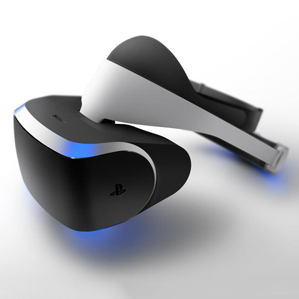- By Simon Parkin on March 19, 2014

Sony unveiled its long-rumored virtual reality headset on Tuesday at the 2014 Game Developer’s Conference in San Francisco. Shuhei Yoshida, president of Sony’s Worldwide Studios, stood in front of a packed auditorium of game developers and said: “Virtual reality is the next innovation from PlayStation that could shape the future of video games.”
Code-named Project Morpheus (a name Yoshida admitted the company only settled on within the past few weeks), the headset will work with Sony’s PlayStation 4 video game console (see “Xbox vs. PlayStation: Beginning of the End for Consoles?”). The headset, which Sony said has been in development for three years, will use inertial sensors built into the head-mounted unit and the PlayStation camera to track a user’s orientation and movement. As the player’s head rotates, the image of the virtual world rotates in real-time.
The headset includes a five-inch LCD panel and 90-degree field of vision. It contains a gyroscope, an accelerometer, and 3-D audio. Morpheus has a light, slick design: a black, rounded visor that hangs solidly from a white curved headband. However, Sony has been quick to point out that neither the specifications nor design are fixed as yet.
“Morpheus enables developers to create experiences that deliver a sense of presence—where players feel as though they are physically inside the virtual world of a game,” said a Sony spokesperson. “Presence is like a window into another world that heightens the emotions gamers experience as they play.”
Richard Marks, one of Project Morpheus’s creators, described his experience with the technology: “When I first experienced presence it shifted my skepticism into complete belief.”
The decision to unveil the technology at an event for game developers rather than to the general public was a tactical one. Sony no doubt hopes to replicate the groundswell of independent developer support that created such a buzz around Oculus Rift. This rival headset, first announced in 2012 and slated for release later this year, is a PC-compatible device that has dominated the conversation around virtual reality (see “Virtual Reality Startups Look Back to the Future”). Sony’s Yoshida paid tribute to Oculus Rift in his presentation. “I have an enormous amount of respect for them,” he said. “We were inspired in our work by the enthusiastic reactions of developers and journalists who tried their prototypes.”
Enthusiasm for Oculus Rift has been tempered by some skepticism. Some observers argue that VR is a gimmick that soon wears thin—as evidenced by the technology’s disappearance in the 1990s. Others complain that such headsets often make players nauseated.
Even so, Sony’s announcement adds to the sense that VR’s time has come. While Oculus Rift has the sizeable benefit of being first, Project Morpheus will benefit from Sony’s marketing clout and the installed base of six million PlayStation 4 owners. And unlike Oculus Rift, Sony’s device will benefit from running on hardware with fixed specifications.


